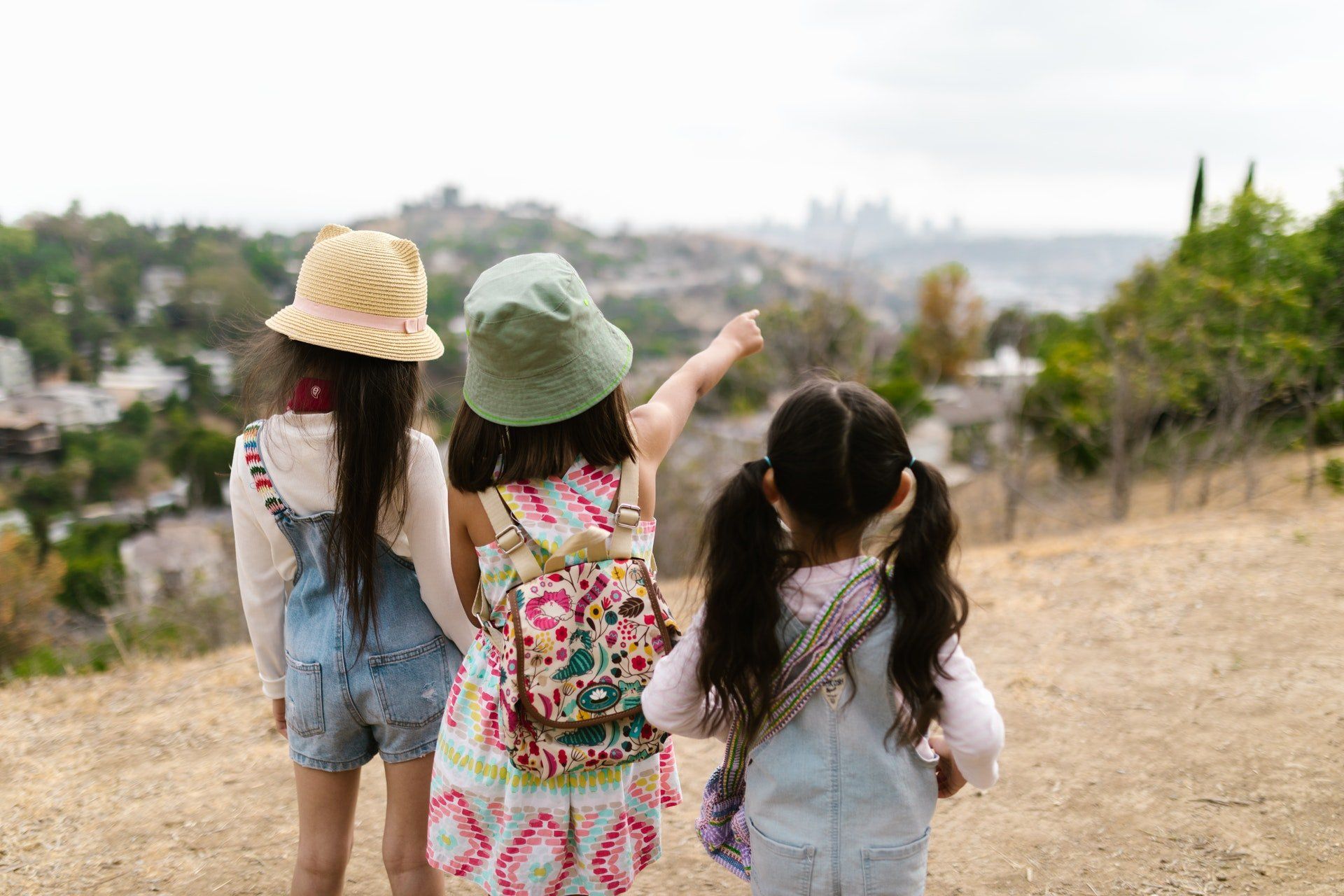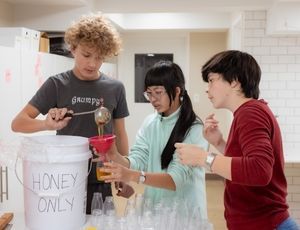End-of-Summer Bucket (and Book!) List

In Montessori, we believe that learning isn’t just something that happens at school. Children are naturally curious and want to discover, explore, and learn. By the end of the summer, they are often eager for opportunities to expand their awareness and engage in something meaningful. So why not use these last weeks of summer as an occasion to soak in experiences that will feed your child’s sense of wonder!
To inspire some end-of-summer adventures, this week we are combining the idea of a summer bucket list with our curated book list!
If your child is older, you can share or post this list and offer a challenge to see how many items they can accomplish before school begins. For younger children, you can use the list as a source of inspiration to enjoy some special time together.
We’ve included some of our favorite titles under each bucket list item. Heading to the library to gather books on the topic can inspire further exploration or even spark some interest. Although most of the books included are picture books, wordless books, or early readers, even older children can be inspired by a book left out on the kitchen table! Be sure to click on the book title to access the Goodreads description.
Happy adventuring!
Climb a hill or a mountain. Explore a new hiking trail.
Hike by Pete Oswald
The Hike by Alison Farrell
Walk, bike, or skate along a bike path.
Along a Long Road by Frank Viva
Canoe or raft on a local river.
River by Elisha Cooper
The Raft by Jim LaMarche
Explore a nature area near your house.
I Took a Walk by Henry Cole
Nature Anatomy: The Curious Parts and Pieces of the Natural World by Julia Rothman
A Walk in the Woods by Christin Couture
Climb a tree.
Just Like Me, Climbing a Tree: Exploring Trees Around the World by Durga Yael Bernhard
The Magic and Mystery of Trees by Jen Green, illustrated by Claire McElfatrick
Learn how to use a compass and map to find your way.
How to use a compass for kids (and adults too!): Your Little Guide to Becoming an Expert Navigator With a Trusty Compass by Henry D Bridges
My Heart Is a Compass by Deborah Marcero
Learn how to pitch a tent, make a fire, and cook breakfast outdoors.
S Is for S’mores: A Camping Alphabet by Helen Foster James, illustrated by Lita Judge
The Kids Campfire Book: Official Book of Campfire Fun by Jane Drake and Mordicai Gerstein, illustrated by Heather Collins
Toasting Marshmallows: Camping Poems by Kristine O’Connell George, illustrated by Kate Kiesler
Make sandcastles on the beach.
A Day for Sandcastles by Jonarno Lawson, illustrated by Qin Leng
Make mud pies.
Mud Book: How to Make Pies and Cakes by John Cage & Lois Long
Mud by Mary Lyn Ray
Search for invertebrates in seaside rock pools or woodland streams.
What's in the Tide Pool? by Anne Hunter
A River by Marc Martin
Build a fort or lean-to in the woods.
Fort-Building Time by Megan Wagner Lloyd, illustrated by Abigail Halpin
A Kids' Guide to Building Forts by Tom Birdseye
Spend some hours making dams and bridges on little streams.
Streams and Ponds: My Nature Sticker Activity Book by Olivia Cosneau
All the Water in the World by George Ella Lyon, illustrated by Katherine Tillotson
Build, Beaver, Build!: Life at the Longest Beaver Dam by Sandra Markle, illustrated by Deborah Hocking
We're Going to Build a Dam by Gillian McClure
Try catching frogs.
ribbit by Jorey Hurley
a boy, a dog, and a frog by Mercer Mayer
Try catching fireflies in a jar.
Fireflies by Julie Brinckloe
Fly, Firefly by Shana Keller, illustrated by Ramona Kaulitzki
Learn how to identify a few constellations and how to find the North Star.
Wishing on a Star: Constellation Stories and Stargazing Activities for Kids by Fran Lee
Glow-in-the-Dark Constellations by C. E. Thompson
Zoo in the Sky: A Book of Animal Constellations by Jacqueline Mitton
Once Upon a Starry Night: A Book of Constellations by Jacqueline Mitton
Learn where north, south, east, and west are in relation to your home.
The Compass Rose and Cardinal Directions by Caitlin McAneney
Maps and Globes: A New True Book by Ray Broekel
Maps and Globes by Jack Knowlton, illustrated by Harriet Barton
Watch the Perseid meteor shower.
(which peaks August 11-12)
Meteor Showers (True Book: Space) by Jane Kelley
Exploring Meteor Showers (Discover the Night Sky) by Brigid Gallagher
Build a birdhouse (here are some good reasons why!).
Bird House by Blanca Gómez
Building Birdhouses (How-to Library) by Dana Meachen Rau, illustrated by Kathleen Petelinsek
The House I'll Build for the Wrens by Shirley Neitzel, illustrated by Nancy Winslow Parker
Ask your parent or grandparent to teach you how to whittle a piece of wood.
Forest Craft: A Child's Guide to Whittling in the Woodland by Richard Irvine
Whittling Projects for Adventurous Kids by Floris Books
Be able to name the local birds in your neighborhood (use binoculars, learn to recognize bird songs, etc.).
Backpack Explorer: Bird Watch: What Will You Find? by Editors of Storey Publishing, illustrated by Oana Befort
Bird Watch by Christie Matheson
My Awesome Field Guide to North American Birds: Find and Identify Your Feathered Friends by Mike Graf
Have You Heard The Nesting Bird? by Rita Gray, illustrated by Kenard Pak
Learn the names of the trees on your property or in your area.
Backpack Explorer: Discovering Trees: What Will You Find? by Editors of Storey Publishing
Trees (Field Guides for Kids) by Andrea Debbink
Collect something and make a little museum at home (shells, rocks, feathers, postcards of natural wonders, etc.).
What’s in Your Pocket? Collecting Nature’s Treasures by Heather L. Montgomery, illustrated by Maribel Lechuga
The Amazing Collection of Joey Cornell: Based on the Childhood of a Great American Artist by Candace Fleming, illustrated by Gérard DuBois
Rocks in His Head by Carol Otis Hurst, illustrated by James Stevenson
Keep a Nature Journal.
The Boy Who Drew Birds: A Story of John James Audubon by Jacqueline Davies, illustrated by Melissa Sweet
A Seed Is Sleepy by Dianna Aston, illustrated by Sylvia Long
Dig for worms.
An Earthworm's Life by John Himmelman
Yucky Worms by Vivian French, illustrated by Jessica Ahlberg
Go fishing.
Over and Under the Pond by Kate Messner
H Is for Hook: A Fishing Alphabet by Judy Young
Go for a night hike with a flashlight.
Flashlight by Lizi Boyd
Night Walk by Sara O'Leary, illustrated by Ellie Arscott
Pick fresh berries and bake a pie.
Wild Berries by Julie Flett, translated by Earl N. Cook
Pie for Breakfast: Simple Baking Recipes for Kids by Cynthia Cliff
Blueberries for Sal by Robert McCloskey






